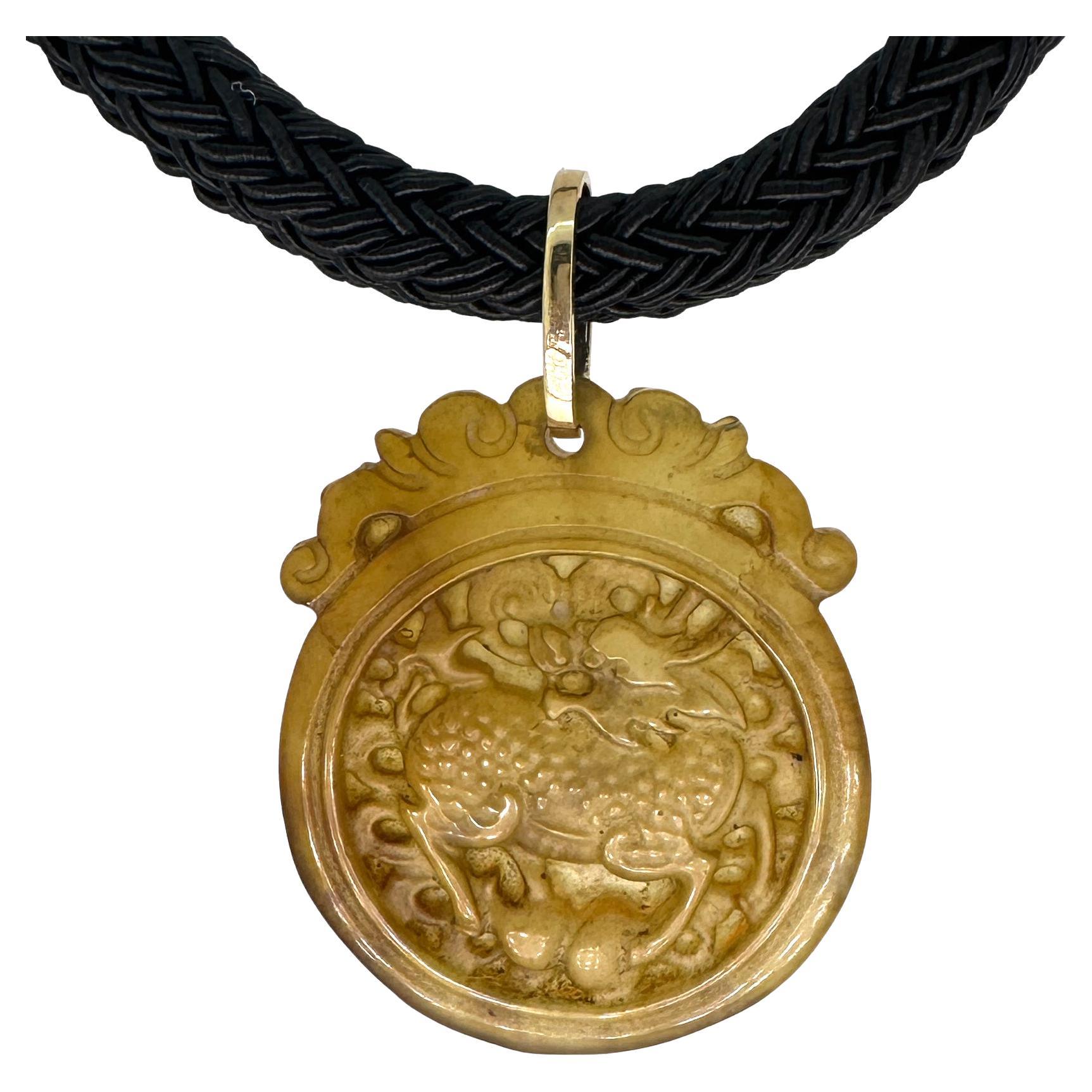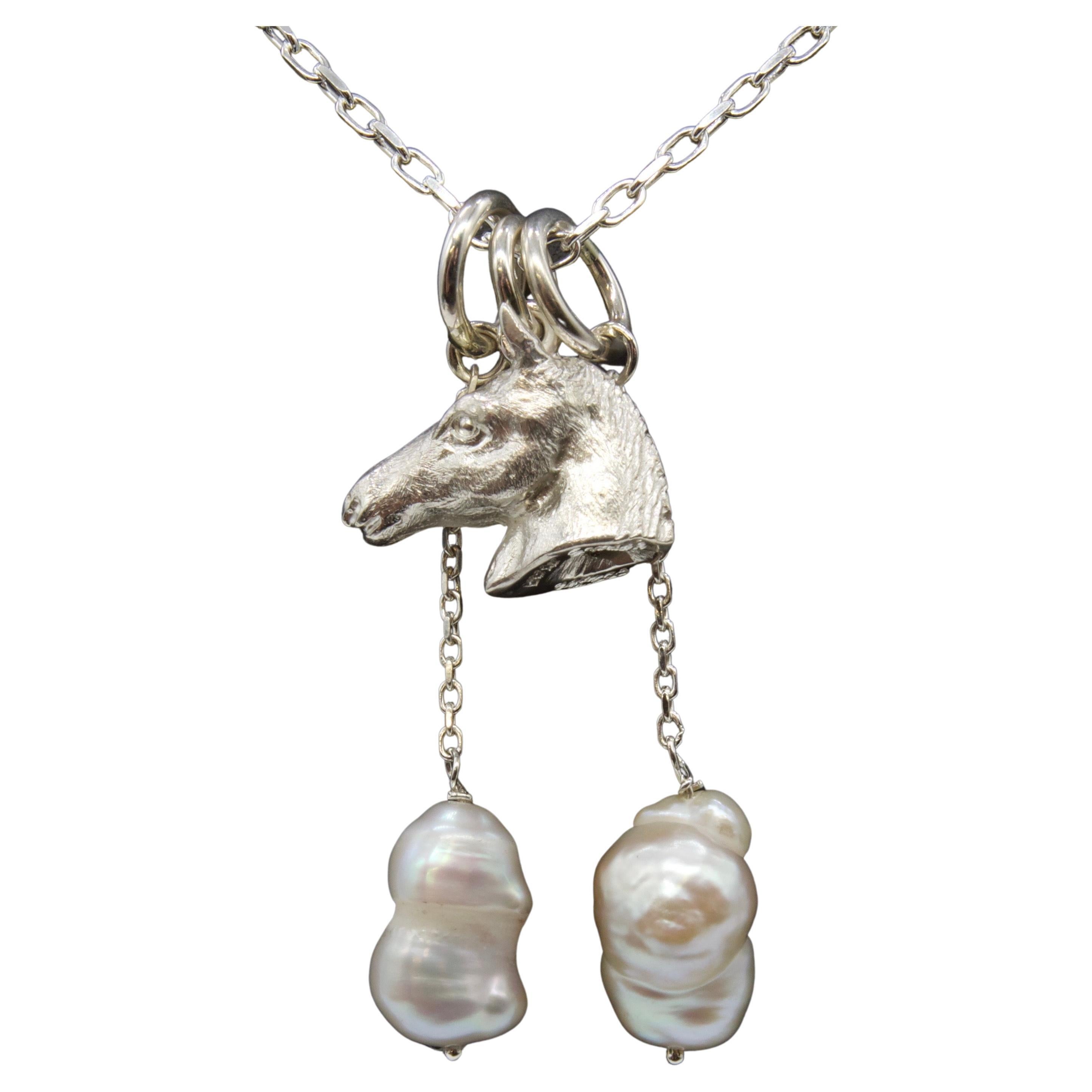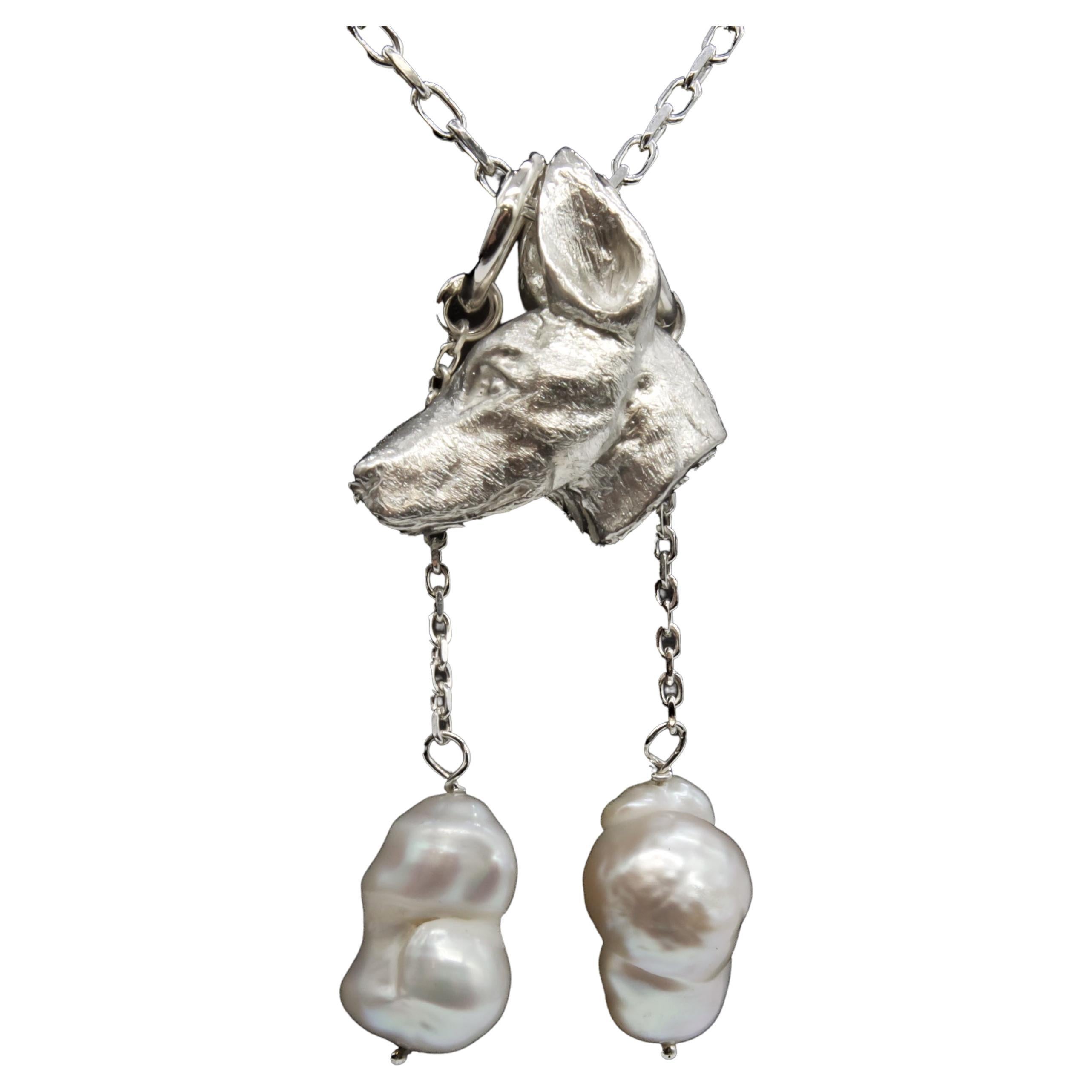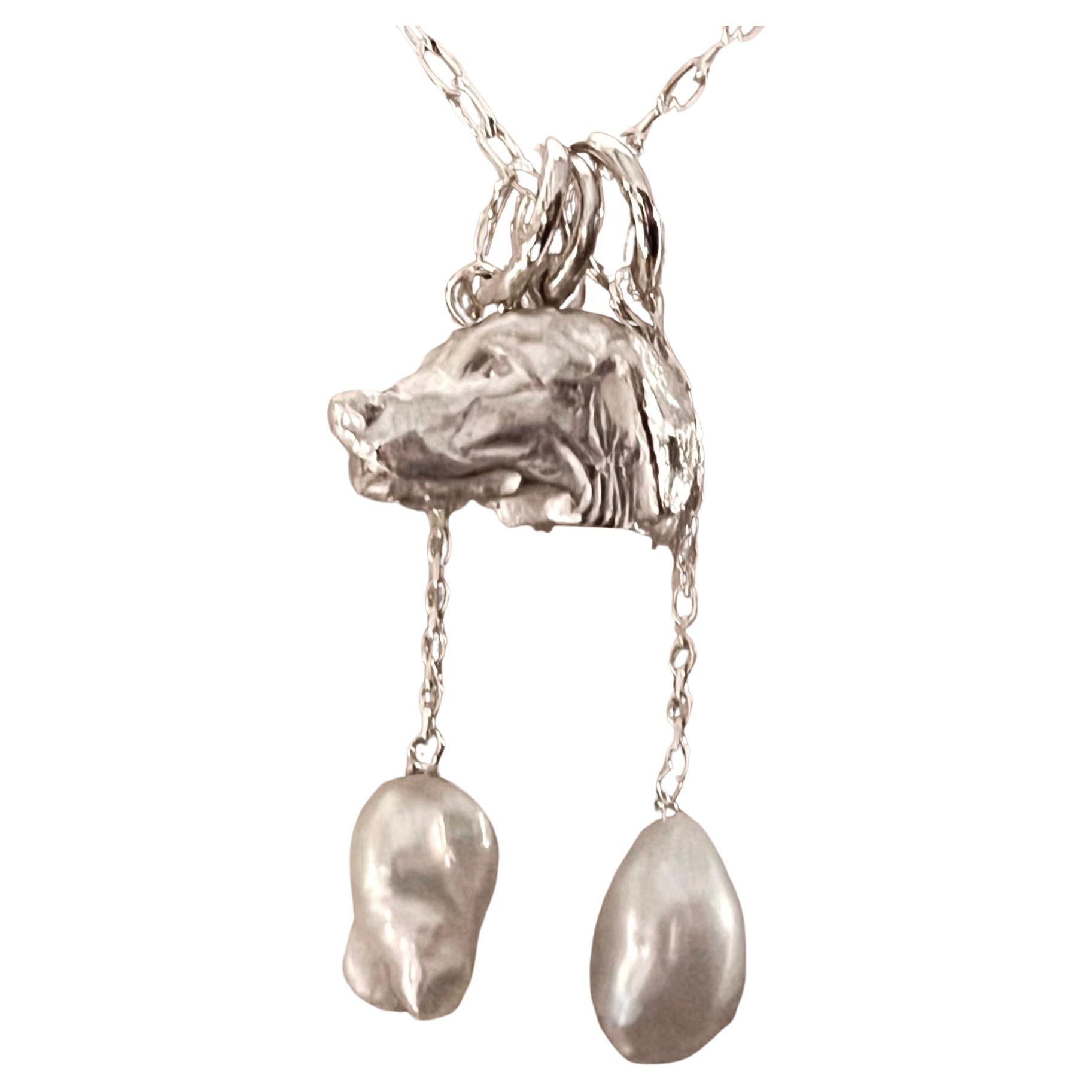Items Similar to Antique Spanish Jet Amulet Pendant with Figa
Video Loading
Want more images or videos?
Request additional images or videos from the seller
1 of 6
Antique Spanish Jet Amulet Pendant with Figa
About the Item
AMULET PENDANT WITH FIGA
Spain, c. 1620–1630
Jet, silver, and enamel
Weight 60.7 grams; dimensions 85 × 49 × 18 mm
Large pendant in the shape of a hand carved from jet with a clinched fist in the figa (Spanish higa) gesture. In the palm of the hand is a heart carved in relief and on the back a six-ray star in a circle. The silver mount covers the wrist like a cuff and is decorated with a frilled border, and on the front with collet-set bosses with silver C-scrolls against blue enamel; on the back is a roundel in relief with floral motif. Domed base for the pendant loop in pea-pod form.
The figa (also fica or higa) represents an age-old symbol of protection against the evil eye and other demonic threats. Its origins were pagan and buried deep in antiquity. Roman examples, such as one found recently in an archeological excavation in London, also make it clear that the protective qualities are based in a sexual symbolism–particularly the power of the phallus. The Roman bone figa/phallus in effect represents the phallus twice; that is, the gesture made by the figa hand is generally explained as fingers representing the female genitalia (vulva) penetrated by the phallus of the thumb. But other interpretations are less specific, including explanations that the left hand is the feminine principle, and the right hand is the masculine.
In Spain, jet figa are common; we see one in the portrait of Anne of Austria the infanta (p. 75). That is not to say that the objects are not sumptuous or treasured. Jet was a very valuable material, and in many examples like this one, the figa is embellished with beautiful enameling or is even gem-studded. Comparable objects occur in equally sumptuous materials such as rock crystal.
The enameled setting allows a dating of these objects that otherwise might prove difficult, given that the production of such objects in Spain is so consistent over centuries. Indeed, there is another, even more elaborately carved example in this collection, attached to the “magic belt” (no. 9). That example may belong to an earlier group.
That figa includes deeply excavated carving, including on the upper surface, an M-shaped design that Walter Leo Hildburgh links to the heart shape (as it occurs more explicitly on this example). Hildburgh argues that its presence is especially common on these objects and that it originally represented the Sacred Heart of Mary, only eventually changed to her initial. He notes that the heart, along with the moon–also associated with Mary as the symbol of the Immaculate Conception–and the five- or six-pointed star were common forms found on figa. Hildburgh, a famous American collector and scholar of folklore and amulets who donated more than five thousand objects to the Victoria and Albert Museum, noted that the six-pointed star was considered amuletic by both Jews and Muslims. Here, however, in combination with the heart, it must be Christian.
Finally, in referencing Hildburgh’s comment we raise the question of why such an amulet defending against the evil eye should occur in a Christian context. Perhaps it seems logical on a “magic belt,”’ but examples occur in paintings of the Christ Child, together with reliquaries and crosses, and some figa even contain images of saints or are attached to crucifixes. Clearly the meaning has been Christianized. And defense against the evil eye is an activity as normal as crossing oneself against demonic influence or evil.
Comparisons and Literature: The closest example for the jet hand is in the Museo Arquelógico Nacional, Madrid (Franco Mata 1986, p. 159, figs. 29-30, first half seventh century). For the more stylized hand with figa, cf. no. 9 and Franco Mata 1986, pp. 158-62; Roman 1987, pp. 27-28. Further for the use of jet in Spain, see Muller 1987, pp. 101-12. The blue enameled boss suggests a date for the pendant around 1620 to 1630; this ornamental motif can be found in sacred and secular silver and is described as the austere style of Philip II (1527-1598), though more prevalent under Philip III and IV; see Oman 1968, pp. xxviii-xxxi, figs. 237-45, all dated about 1620-30.
- Metal:
- Weight:60.7 g
- Dimensions:Width: 3.35 in (85 mm)Depth: 0.71 in (18 mm)Length: 1.93 in (49 mm)
- Place of Origin:
- Period:Early 17th Century
- Date of Manufacture:1620-1630
- Condition:Wear consistent with age and use.
- Seller Location:Chicago, IL
- Reference Number:
About the Seller
5.0
Vetted Seller
These experienced sellers undergo a comprehensive evaluation by our team of in-house experts.
Established in 1991
1stDibs seller since 2021
5 sales on 1stDibs
Typical response time: 13 hours
- ShippingRetrieving quote...Ships From: Chicago, IL
- Return PolicyA return for this item may be initiated within 3 days of delivery.
More From This SellerView All
- Antique Silver Spanish Cross Pendant with Rock CrystalsLocated in Chicago, ILCross Pendant with Rock Crystals Spain or Portugal, late 17th - early 18th century Silver, gold, rock crystal Weight 9.1 gr.; Dimensions 56.3 × 38.8 mm. An elaborate and elegant cross pendant made of silver with rock crystals in closed settings. The center consists of a larger round gemstone surrounded by five irregular-shaped stones forming the cross. The openwork arms have a triangular shape and are formed of facetted rock-crystals in foliate settings. The obverse side of the cross consists of a layer of gold. An extension with two stones and an angular shaped frame is hooked into the pendant loop, probably to be worn on a velvet band. The pendant is in good, wearable condition. After the Reformation, cross pendants were worn mainly in Catholic countries by men, women, and children. During the seventeenth century, the designs became ever more intricate, and the crosses were often embellished with gemstones, such as rock crystals in this example. These were sourced along the Alpine regions of France, Switzerland, Austria, and Southern Germany. The stones gave the appearance of diamonds. The foliate settings are characteristic of late seventeenth- and eighteenth-century jewelry made in Spain...Category
Antique Late 17th Century Pendant Necklaces
MaterialsCrystal, Rock Crystal, Gold, Gold Plate, Silver
- Antique Spanish Hat Badge Pendant Carved in JetLocated in Chicago, ILBADGE WITH ST. JAMES THE GREAT Northern Spain, 16th century Silver, jet Weight 18.2 grams; dimensions 44 × 43 × 12 mm Round pendant with high-relief image of St. James the Great of Santiago de Compostela carved in jet. The saint is flanked by two pilgrims (their heads defaced); each holds a staff and rosary in his hand. Silver mount with plain flat backplate, corded wire surround and toothed edge as setting. Four pendant loops for sewing onto a hat or cloak. According to the Roman naturalist Pliny, jet, the material of which this pin was made, prevented snakebite and was “thrown up by the sea.” The first quality would certainly have been reassuring for a pilgrim who owned this object and who had to make long journeys over unfamiliar terrain. The second quality made jet an especially fitting material to honor St. James, given that his body arrived in Spain mysteriously, carried there “by the sea” from the Holy Land. Santiago de Compostela was a major center for jet carving from the late Middle Ages, and highly polished jet was a desirable and common material for pilgrimage souvenirs. One even finds scallop shells, the pilgrim’s badge...Category
Antique 16th Century Spanish More Objets d'Art and Vertu
MaterialsSilver
- Fifteenth Century Reliquary Pendant with Christ on the CrossLocated in Chicago, ILReliquary Pendant with Christ on the Cross Germany, c. 1480–1500 Gilded silver Weight 35 grams; dimensions 69 × 46 × 8 mm A mixture of forms gives t...Category
Antique 15th Century and Earlier German Figurines and Sculptures
MaterialsSilver, Gilt Metal
- Antique Gold Pendant with Diamonds and PearlsLocated in Chicago, ILPendant with Virgin Mary as Queen of Heaven Western Europe, Southern Germany (?), Italy (?), c. 1550-1560 Gold, enamel, diamonds, and pearls Weight 13.2 gr; Length 36.9 x 31.2 mm (incl. pearls) This sumptuous image exudes regal power. It portrays the Virgin Mary as Queen of Heaven wearing a dress and crown studded with seven large diamonds and set against a translucent, rich blue celestial background. Far removed from the tender, humble Virgin seen in German and Netherlandish artworks of the period, she is a majestic ruler, mouth sternly set, head tilted upward, and face in full profile. The oval pendant cast in high gold relief with a central medallion, the single figure filling the space, echoes jewelry portraits of the aristocracy during the Renaissance, which similarly offset the ruler’s image against a blue field composed of enamel or lapis lazuli, symbolic of divine power Only the rays of the shining gold halo that emerge behind the Virgin’s head and her long flowing hair (instead of neatly coiffed) distinguish her from female ruler portraits of the period. Three studded pearls, forming an axis, also recall pendants of European rulers. Wealth, royal status, and divine power come together in this opulent pendant. Portraits of the period show similar small oval pendants worn by women in the square of the garment or by men nestled inside multiple chains below the base of the neck. PROVENANCE European Private Collection LITERATURE Compare images from ancient Rome, for example a sardonyx cameo with female head (Kugel 2000, no. 18; Milan, c. 1550), and a pendant with gold, pearls, and enamel in the Staatliche Museum Kassel (Schmidberger/Richter 2001, no. 43; France, c. 1555-1560). For ruler pendants with blue backgrounds see a pendant of King Frances I...Category
Antique 16th Century Pendant Necklaces
MaterialsDiamond, Pearl, Gold
- Antique Double Sided Rosary Bead with Head of Christ and Skull Carved in BoneLocated in Chicago, ILROSARY BEAD WITH WENDEKOPF Germany, 16th century Bone Weight 12 grams; dimensions 29 × 23 × 24 cm A double-sided bead made of bone with a finely carved head of Christ on one side an...Category
Antique 16th Century German Figurines and Sculptures
- Antique Reliquary Book Pendant LocketLocated in Chicago, ILRELIQUARY PENDANT IN BOOK FORM Probably southern Germany, 1630–40 Gilded silver, verre églomisé Weight 13.2 grams; dimensions 42 × 25 × 12 mm; opens to 40 mm Gilded silver pendant in book form with hinged, lid, corded wire surround, and engraved spine. The front cover of the book is set with a plaque depicting Moses receiving the Law in verre églomisé, and the back cover shows the Sacrifice of Abraham. The scenes are in gold against a red background. When opened, the book reveals two portraits, probably of a husband and wife, wearing seventeenth-century dress. The costumes suggest a date c. 1630-40; the wife holds a daisy. Trefoil-shaped pendant loop on top and bottom, and book clasp. As in the scenario described for the assemblage of these pendant miniature books (see no. 34), this book may have satisfied the desires of a particular patron, perhaps even one of the Jewish faith. The images that have been chosen for the four verre églomisé inserts are somewhat unusual within the group of comparable objects; on the front is Moses, on the back is the Sacrifice of Isaac. On the inside, instead of an iconic or doctrinal image, one sees portraits of the patron and his wife, in their finest dress, contents reminiscent of a modern locket...Category
Antique Mid-17th Century Pendant Necklaces
MaterialsGilt Metal
You May Also Like
- Large Chi Ling Dragon Amulet in Nephrite Jade, circa 1970, with 14k Gold BaleLocated in Sherman Oaks, CAWe acquired this dragon plus eight other nephrite amulets in 2020. In order to better understand our acquisition, we had the lot verbally appraised by David Ha of Ha Dynasty Jewelry...Category
Late 20th Century Chinese Figurines and Sculptures
MaterialsJade, Gold, 14k Gold, Yellow Gold
- Antique White Nephrite Jade Carved Pendant "Mutton Fat" CertifiedLocated in Southbury, CTSubtle and achingly beautiful, this antique hand-carved jade pendant depicts a feline curled in contentment. The carving was most likely created near the turn of the previous century (circa 1899) though it could be older. The jade is white nephrite, among the most prized varieties of jade and known more commonly as "mutton fat...Category
Antique 1890s Chinese Artisan Pendant Necklaces
MaterialsJade
- Paul Eaton Sculpted Horse Head Pendant with One or Two Pearl DropsLocated in Charleston, SCMiniature wildlife artist, Paul Eaton from England, hand sculpted a horse head pendant (3/4"w x 5/8"h x 3/8"d) which is elegantly framed with one or two drop freshwater pearls (...Category
2010s British Contemporary Pendant Necklaces
MaterialsFreshwater Pearl, Pearl, Sterling Silver
- Paul Eaton Sculpted Greyhound Dog Head Pendant with One or Two Pearl DropsLocated in Charleston, SCMiniature wildlife artist, Paul Eaton from England, hand sculpted a Greyhound dog head pendant (3/4"w x 1/2"h x 3/8"d) which is elegantly framed with one or two drop freshwater pearls (2"h). The bespoke Greyhound dog sculpture is made into jewelry you can wear close to your heart. Paul Eaton possibly the world's best miniature sculptor of animals is also a professional gold/silversmith. Born in London Paul Eaton soon moved to the countryside where his love of wildlife started thus enabled him to produce sculpture with finite detail. Paul carves his original sculptures from wax, then casts in metals. Each are cast individually and hand finished. Paul Eaton’s jewelry can be customized with any animal in Sterling, 9ct, 18ct and any combination of metal or stones. The Greyhound pendant...Category
2010s British Contemporary Pendant Necklaces
MaterialsPearl, Freshwater Pearl, Sterling Silver
- Paul Eaton Sculpted Doberman Dog Head Pendant with One or Two Pearl DropsLocated in Charleston, SCMiniature wildlife artist, Paul Eaton from England, hand sculpted a sterling silver Doberman dog head pendant which is elegantly framed with one or two drop freshwater pearls. ...Category
2010s British Contemporary Pendant Necklaces
MaterialsPearl, Freshwater Pearl, Sterling Silver
- Paul Eaton Sculpted Retriever Dog Head Pendant with One or Two Pearl DropsLocated in Charleston, SCMiniature wildlife artist, Paul Eaton from England, hand sculpted a Retriever dog head pendant which is elegantly framed with one or two drop freshwater pearls. The bespoke Retriever...Category
2010s British Contemporary Pendant Necklaces
MaterialsFreshwater Pearl, Pearl, Sterling Silver
Recently Viewed
View AllMore Ways To Browse
Studs On Belts
Antique Jewellery Group
Antique Jewelry Group
Blue Moon Antique
Antique American Childs
Antique Star Necklace
Antique Initial Necklace
Antique Initial Pendant
Antique Bone Carvings
Antique Bone Carving Antiques
Museum Quality Antique Jewellery
Antique Christian Jewelry
Antique Silver Belt
Antique Silver Belts
Carved Jet
Carved Bone Jewelry
Heart Cross Necklace
Five Pointed Star





